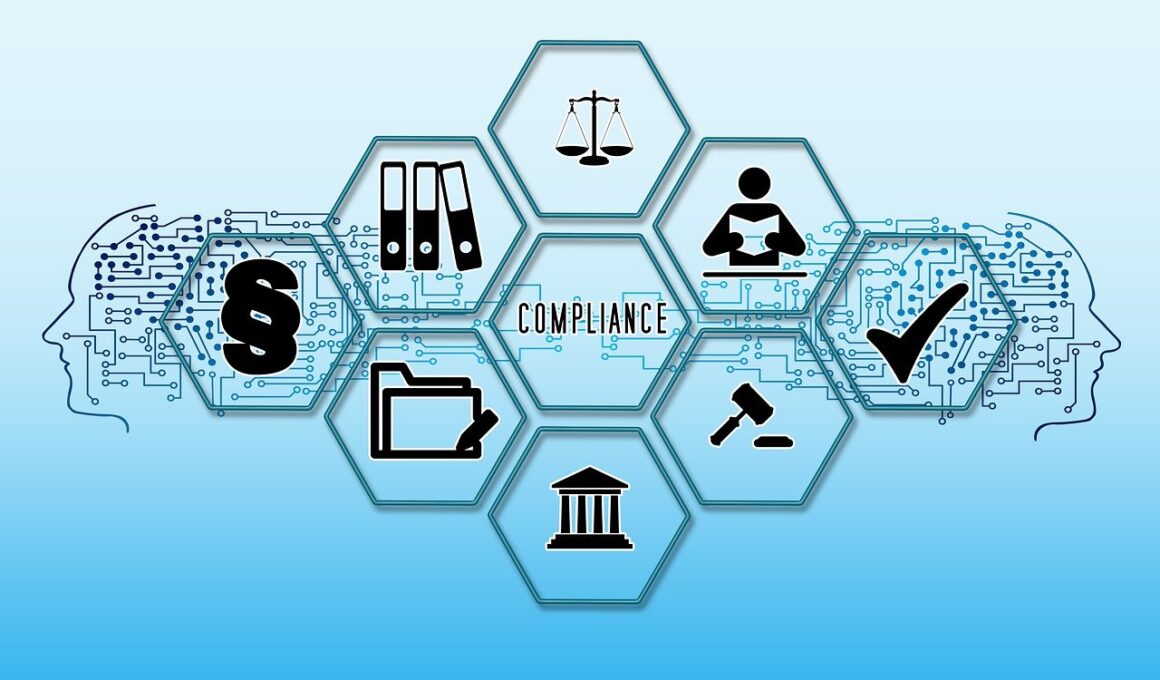The Importance of a Strong Compliance Culture in Risk Management
In today’s fast-paced business environment, the significance of a robust compliance culture cannot be overstated. Compliance is a strategic necessity that ensures organizations adhere to laws, regulations, standards, and ethical practices. Establishing a strong compliance culture fosters awareness and guides employee behavior towards making sound decisions that adhere to regulatory requirements. This cultural commitment helps mitigate risks associated with discrepancies and malpractices. A commitment to compliance imbues the workforce with a clear understanding of the regulatory landscape, thus empowering them to alert management to any compliance issues that arise. Ultimately, instilling a compliance-centric ethos becomes a cornerstone for building trust with stakeholders, enhancing reputation, and promoting sustainable business practices. Regular training sessions and open communication channels ensure that all employees understand their role in compliance, which is particularly crucial as regulations evolve. Moreover, integrating compliance into decision-making processes ensures that organizations can promptly adapt to regulatory changes, thereby maintaining operational integrity and stability. A strong compliance culture also enhances overall organizational resilience, enabling businesses to withstand crises and shocks while adhering to ethical standards. Building this culture is a continuous process that requires commitment from leadership and active participation from all employees.
Elements of a Compliance Culture
Key elements that constitute a strong compliance culture include clear policies, visibility from leadership, and continuous education. Establishing comprehensive policies allows employees to know the rules that govern their actions, reducing uncertainty. When leadership demonstrates a visible commitment to compliance, it inspires employees to follow suit. Management should model the behavior they wish to see, reinforcing the importance of adherence to compliance protocols. Continuous education serves to keep employees informed about changes in regulations and compliance expectations, which is essential in an ever-evolving landscape. Regular workshops, seminars, and updates are crucial in ensuring that employees are not only aware of existing regulations but are also prepared for potential changes. Furthermore, creating a safe environment for reporting compliance concerns promotes transparency and accountability. Employees must feel secure when raising issues without fear of repercussions. Encouraging open dialogues about compliance fosters engagement and strengthens the organization’s ethical framework. Lastly, rewarding compliance-oriented behaviors can further instill a culture where adherence to rules and regulations is recognized and valued. This holistic approach builds a robust foundation for compliance that permeates every level of the organization.
In addition to the elements mentioned, it is essential to have a well-defined compliance program that is tailored to specific organizational risks. Identification of potential compliance risks should be undertaken through regular assessments which are critical in preventing issues before they escalate. A proactive approach towards compliance, by conducting these assessments, helps in pinpointing areas needing improvement. Additionally, leveraging technology for compliance monitoring and reporting streamlines processes. Implementing compliance software enables organizations to track changes in the regulatory environment efficiently, ensuring swift adaptations are made. By utilizing automated tools for documentation, organizations can maintain comprehensive records, which are essential for audits and evaluations. A transparent compliance framework is typically characterized by accessible documentation, making it easier for both internal teams and external auditors to navigate. This transparency is vital for establishing credibility with stakeholders. Moreover, metrics should be established for measuring compliance program effectiveness. Regularly reviewing these metrics provides insights into areas requiring attention and allows organizations to quantify improvements over time. As the organization evolves, the compliance strategy must reflect these changes, reinforcing its dedication to maintaining a strong compliance culture.
Training and Employee Engagement
Effective training is fundamental in nurturing a strong compliance culture within any organization. Comprehensive training programs should be tailored to the diverse needs of employees, ensuring that everyone, regardless of their role, understands compliance expectations. These training sessions must go beyond merely fulfilling regulatory requirements; they should engage employees in discussions about ethical dilemmas and case studies pertinent to the industry. Incorporating interactive methods, such as role-playing or group discussions, can enhance understanding and retention. Employee engagement is critical in promoting compliance awareness; thus, soliciting feedback regarding training programs fosters a sense of involvement. Furthermore, establishing compliance champions within teams can encourage peer-to-peer discussions and support. These champions act as resources to disseminate compliance information, thus broadening the compliance support network across the organization. When employees feel they have a voice in compliance matters and see their suggestions implemented, motivation levels rise, and adherence increases. Management should also recognize and highlight the contributions of individuals or teams excelling in compliance. This approach not only reinforces the importance of compliance but also fosters a culture of accountability, where employees hold themselves and others to high standards of ethical conduct.
Moreover, a collaborative approach towards compliance can significantly enhance its effectiveness. By encouraging interdepartmental communication regarding compliance issues, organizations can break down silos that might hinder a cohesive compliance culture. When departments work collaboratively, they can share insights and experiences, leading to a more comprehensive understanding of compliance challenges organization-wide. This collaboration should extend beyond problem-solving related directly to compliance; it can also contribute to process optimization that drives compliance. Integrating compliance considerations into various business functions can eliminate the perception of compliance being a standalone concern. For instance, involving compliance teams in project planning ensures that new initiatives are assessed for potential risks from the outset. Additionally, monitoring compliance with regulations should not be viewed as a burden but as an integral part of strategic planning. By positioning compliance as a partner in achieving business objectives, organizations can align compliance goals with overall business strategy. This alignment fosters a culture that views compliance as a value-add rather than a hindrance, encouraging all employees to participate in maintaining regulatory standards while pursuing corporate goals.
Accountability and Transparency
Accountability is a pivotal aspect of a successful compliance culture. Establishing clear roles and responsibilities ensures employees know their part when it comes to compliance. Each team member should understand how their specific actions can contribute to or jeopardize compliance. By assigning accountability at all levels, the risk of compliance failures can be significantly reduced. Regular communication about compliance expectations enables employees to remain informed and prepared to uphold those standards. Additionally, transparency regarding compliance processes and outcomes fosters trust in the organization’s policies. Sharing information about compliance audits, results, and corrective actions taken enhances the credibility of the compliance program and ensures everyone is on the same page. Transparency also helps in building trust with clients and stakeholders, who appreciate openness about an organization’s commitment to regulatory adherence. Moreover, incorporating a feedback loop allows employees to voice concerns or propose improvements in compliance practices, further promoting a culture of accountability. Management should welcome feedback with an open mind and respond constructively to nurture a culture that actively addresses compliance issues. A transparent and accountable compliance culture is ultimately vital for sustaining an organization’s integrity and fostering long-term success.
Finally, measuring the effectiveness of a compliance culture is essential for continuous improvement. Organizations must regularly assess their compliance programs, identifying strengths and areas needing enhancement. Key performance indicators (KPIs) should be established to provide objective insights into compliance adherence and culture. Tracking these metrics over time helps in evaluating the impact of compliance training and initiatives. Conducting employee surveys and satisfaction assessments can reveal how well the compliance culture resonates with the workforce. By analyzing employee feedback, management can identify aspects of the compliance culture that need reinforcement or revision. Additionally, organizations should conduct regular audits to ensure compliance policies are effectively implemented and stringently followed. External audits provide an unbiased overview and can unveil blind spots that internal reviews may overlook. Consistently refining compliance practices ensures that organizations remain resilient in the face of changing regulatory landscapes. Consequently, establishing a culture of continuous improvement ensures that compliance remains an integral aspect of the organization’s values. This commitment fosters an environment where compliance becomes an automatic consideration in all business operations, ultimately leading to greater success and sustainability over time.
In conclusion, it is evident that a strong compliance culture is essential in effective risk management. Organizations that prioritize compliance and embed it into their corporate values create a more resilient and ethical business framework. By fostering a compliance culture characterized by clear policies, robust training, and accountability, organizations can navigate complex regulatory environments with confidence. Leadership must play a central role in promoting this culture by setting an example and encouraging open communication. A collaborative approach to compliance can enhance effectiveness while promoting engagement and motivation among employees. By prioritizing transparency and accountability, organizations can build trust and credibility with stakeholders. Regular assessments and refining of compliance programs further ensure that the organization stays in line with evolving regulations. Ultimately, embedding compliance into every aspect of the organization not only mitigates risks but also contributes to success in achieving business objectives. This holistic view of compliance as an integral part of risk management fosters a sophisticated understanding of the regulatory landscape and paves the way for sustainable growth. As businesses continue to evolve, the significance of a strong compliance culture in risk management cannot be overlooked, serving as a foundation for future success.


